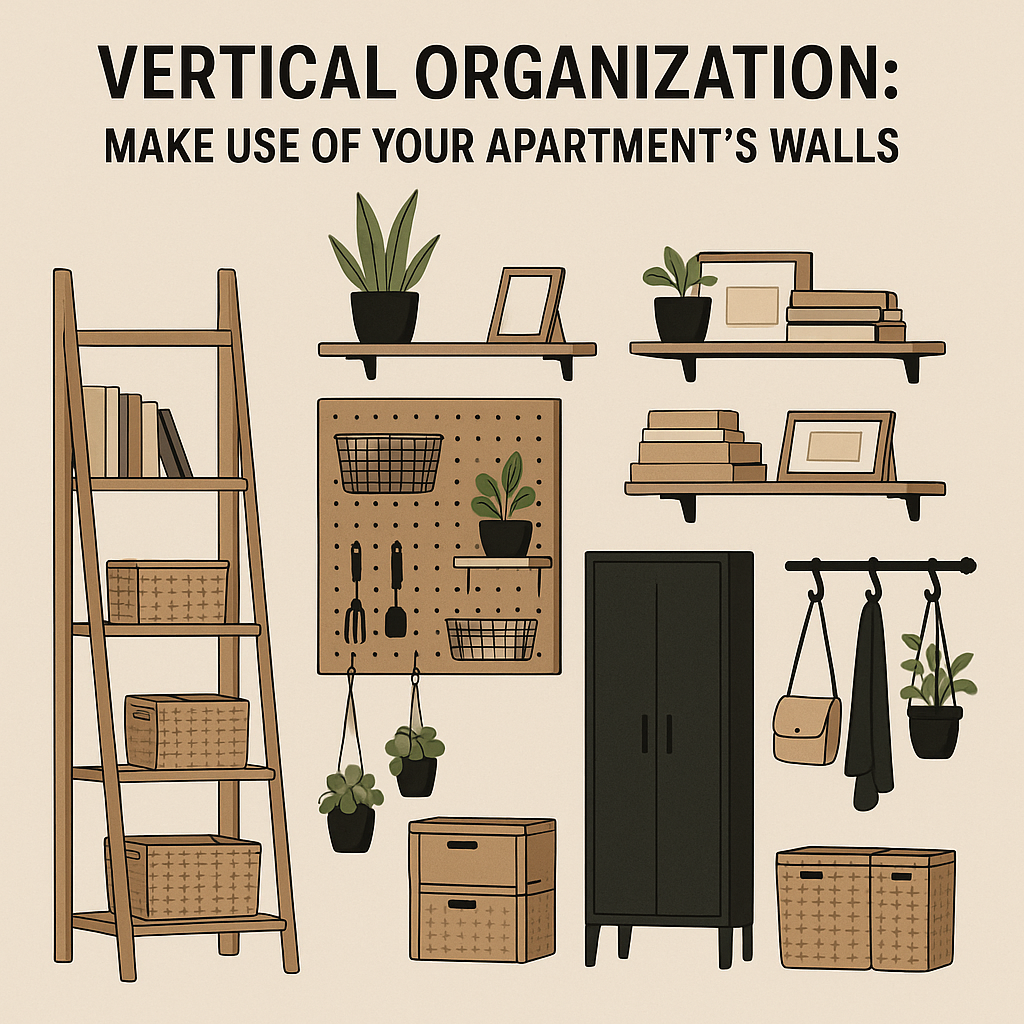When living in a small apartment, maximizing vertical space is one of the most powerful strategies for staying organized and stylish. While floor area may be limited, your walls are full of untapped potential—offering storage, structure, and visual impact without cluttering your layout.
Whether you’re working with a compact studio, a one-bedroom, or even just a small room within a larger home, this guide will show you how to use vertical organization to transform your space with creativity and purpose.
Why Vertical Organization Works
In tight spaces, going vertical is key because it:
- Frees up floor space
- Utilizes overlooked areas
- Creates zones and structure
- Adds storage without bulk
- Improves overall visual flow
Instead of spreading out, you build up—and that changes everything in a small home.
1. Start with a Wall Audit
Before drilling or installing anything, identify walls you can use:
- Behind or above furniture (like sofas, beds, or desks)
- Entryway and hallway areas
- Empty corners
- Over doors and windows
- Inside closets
Consider both practicality (for storage) and visibility (for style). Not every wall needs to be used—but most have some potential.
2. Install Floating Shelves
Benefits:
- Minimalist and stylish
- Easy to install
- Can be customized in length and layout
Use floating shelves to:
- Display books, plants, or decorative items
- Store work supplies above your desk
- Organize bathroom or kitchen items
Style tip: Use three staggered shelves of the same length to create balance, or mix sizes for an eclectic look.
3. Use Wall-Mounted Cabinets or Lockers
For enclosed storage that doesn’t take up floor space, wall cabinets are ideal.
Best used in:
- Kitchens (for dishes, spices, dry goods)
- Bathrooms (for toiletries and towels)
- Home offices (for files, supplies, and equipment)
Choose shallow profiles (15–25 cm deep) to avoid crowding. If you’re renting, look for adhesive-based or removable options.
4. Add Pegboards or Grid Panels
Originally used in workshops, pegboards are now a staple in modern home organization.
Great for:
- Craft supplies
- Office accessories
- Kitchen utensils
- Entryway catch-alls
Add hooks, baskets, or clips to store everything from keys to tools to headphones.
Bonus: Paint the board to match your wall for a custom look.
5. Hang Vertical Bookcases or Ladders
Traditional horizontal bookcases eat up floor space, but vertical models or ladder-style shelves use height efficiently.
Perfect for:
- Displaying plants, books, and framed photos
- Narrow spaces beside beds, desks, or doors
- Creating a room divider effect without blocking light
Style idea: Choose an open-frame ladder shelf to maintain visual lightness.
6. Utilize Wall Hooks, Rails, and Racks
Hooks and rails are small additions with big impact.
Try:
- Key hooks or wall trays near the door
- Coat hooks or wall pegs in the hallway
- Kitchen rails for utensils, mugs, or towels
- Bathroom hooks for robes and accessories
- Vertical bike hooks to store a bicycle on the wall
Use matching hardware for a cohesive look, or mix for personality.
7. Use the Space Above Doors and WindowsOften overlooked, these spaces are perfect for:
Extra shelving
- Decorative ledges
- Book or plant storage
- Seasonal storage bins
Make sure they’re securely mounted, and don’t overload them with heavy items.
8. Install Foldable Wall-Mounted Furniture
Wall-mounted fold-down desks, tables, or ironing boards save space and disappear when not in use.
Great for:
- Home offices in tight corners
- Dining tables in studio apartments
- Craft or sewing stations
- Kids’ homework nooks
Pair with a foldable chair that hangs nearby when not in use.
9. Use Tall Cabinets or Towers
Instead of wide dressers or short cabinets, choose narrow, tall units that reach toward the ceiling.
Ideal for:
- Pantry items
- Linens and towels
- Office supplies
- Bedroom accessories
To keep it balanced, add decorative elements like framed art or plants on top.
10. Organize with Hanging Baskets and Pockets
Great for renters or DIYers, hanging baskets or fabric wall pockets can store:
- Mail and documents
- Toiletries
- Craft tools
- Remote controls and cables
Mount them with adhesive hooks, over-the-door systems, or towel bars.
11. Hang Curtains or Drapes with Shelving
Add a layer of function and softness by installing curtains or drapes over shelving. This technique:
- Hides visual clutter
- Adds color or texture
- Works well in open-plan apartments or studios
Use in closets, open wardrobes, or around utility shelving.
12. Wall-Mounted Plant Systems
Plants make any space feel more vibrant, and when mounted vertically, they take up zero floorspace.
Try:
- Vertical wall planters
- Macramé hanging pots
- Tiered wall racks for herbs or greenery
- DIY wooden slats with plant clips
Just make sure there’s enough light and ventilation, especially near windows.
13. Use Picture Rails or Ledges
Rather than heavy shelves, a picture rail or narrow ledge offers subtle, stylish storage for:
- Framed artwork
- Books
- Decorative objects
- Small plants
They’re ideal above sofas, beds, or workstations.
14. Combine Function with Decor
Vertical organization should be functional and beautiful.
Try grouping:
- Art and lighting (wall sconces above framed prints)
- Hooks and hanging baskets
- Shelves with personal items and practical bins
By treating vertical storage like part of your interior design, it feels intentional—not improvised.
In small apartments, walls are more than just blank canvases—they’re your secret weapon. Vertical organization makes even the tiniest home feel spacious, structured, and serene. Whether you’re adding shelves above your desk or mounting a stylish pegboard near the entry, you’ll be amazed at how much you can store—and how good it can look—when you go vertical.
Stop thinking in square meters. Start thinking in vertical meters.

